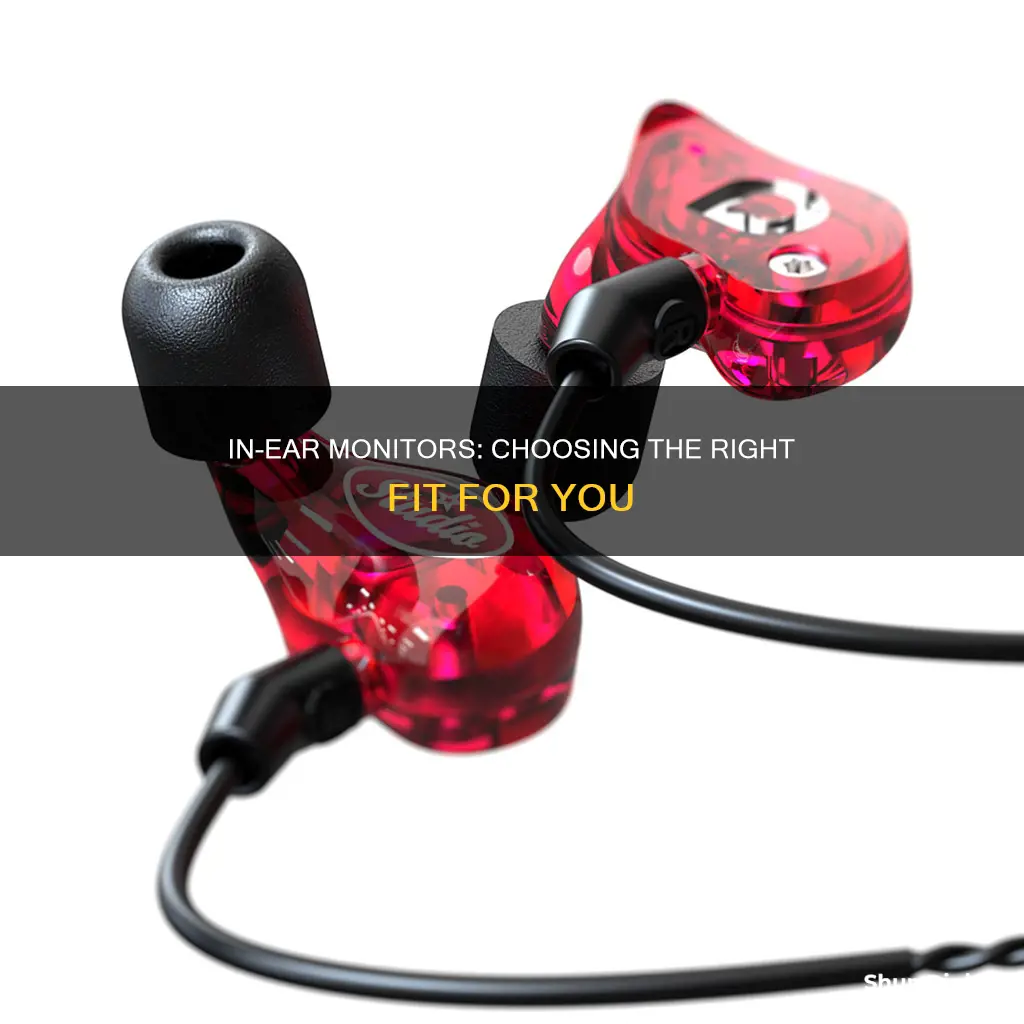
In-ear monitors (IEMs) are a special category of headphones used by musicians and performers to monitor a combination of audio sources in different places. They are also used by listeners in recording studios, radio stations, or during their daily commutes. IEMs are available in a wide range of prices, designs, and sound profiles, and can be purchased at local audio stores or music shops. When buying IEMs, it is important to consider the cable design, cable removability, inline mic, specifications, driver type and number, body material, sound signature, soundstage and imaging, eartips, and price.
| Characteristics | Values |
|---|---|
| Cable Design | Straight or over-ear |
| Cable Removability | Detachable |
| In-Line Mic | Entry-level and mid-range IEMs |
| Specs | Frequency response, sensitivity, and impedance |
| Drivers | Dynamic, balanced armature, planar magnetic, or hybrid |
| Body Material | Metal, resin, carbon fiber, plastic, wood, etc. |
| Sound Signature | Dark, flat, or balanced |
| Soundstage and Imaging | Wider soundstage and good imaging for a more 3D experience |
| Ear Tips | Silicone, rubber, foam, or hybrid |
| Price | Various options ranging from budget to premium |
What You'll Learn

Wired vs wireless
When it comes to in-ear monitors, there are two main options: wired or wireless. Both have their advantages and disadvantages, and the best choice for you will depend on your specific needs and preferences.
Wired in-ear monitors offer a pure, wired sound with no risk of audio dropout or interference. This makes them a good choice for drummers, who are usually stationary on stage. Wired monitors are also generally simpler and more cost-effective, with one less variable to worry about. However, the downside of wired monitors is the restriction of movement due to the cables.
On the other hand, wireless in-ear monitors offer total freedom of movement, making them ideal for singers, guitarists, keyboard players, and anyone else who needs to move around on stage. Wireless monitors allow you to go anywhere you want while still maintaining your monitor mix. However, wireless monitors can be more expensive and may have issues with reception and interference, especially in large cities with a lot of "wireless traffic". Additionally, wireless monitors require more setup and management, as you have to ensure you are out of everyone else's way.
In terms of sound quality, the differences between wired and wireless monitors are typically subtle. In most cases, the sound quality is similar whether the monitors are used wirelessly or wired. However, trained ears or more critical listeners may notice slight variations in the frequency response. Wireless monitors may also have a slight latency issue, which can be disruptive when watching videos or gaming.
Ultimately, the decision between wired and wireless in-ear monitors depends on your specific needs and preferences. Wired monitors offer a reliable, cost-effective option with no risk of audio dropout, while wireless monitors provide the freedom of movement and are ideal for those who need to move around on stage.
Monitoring Water Usage: Strategies for Schools
You may want to see also

Cable design
When it comes to cable design, there are two types of in-ear monitors (IEMs): straight and over-ear. Straight cables hang straight down from the earpieces, similar to regular earphones, while over-ear cables wrap over and around the back of your ears. Most IEMs use the over-ear design as it better secures the earpieces and hides the cables. Straight cables are rarer in higher-end models.
Another aspect of cable design is whether the cables are removable. IEMs have an advantage over regular earphones in that their cables are often detachable, allowing for replacement in case of damage, better organisation, and the option to buy a third-party Bluetooth module to make the IEMs wireless.
IEMs are also available in wired or wireless options. Wired systems are more affordable and can help to avoid issues with compromised audio or interference that can occur with wireless systems. Wireless IEMs, on the other hand, offer greater mobility on stage, with some models offering a transmission range of up to 330 feet.
Additionally, the material of the cables can vary. For example, braided cables can provide additional durability.
Monitor Size Standards: What's the Average?
You may want to see also

Cable removability
One of the unique features of IEMs is their modular nature. Most in-ear monitors have detachable cables and earpieces, which are interchangeable with other models. This means you can swap out the cable for a braided one for added durability or opt for very long wires for live performances.
For example, the Shure SE215 Pro, a popular choice for those new to the world of professional monitoring on stage, features a thickened detachable cable. The Shure SE846 Pro, another highly-rated option, also has a detachable cable.
The Shure EAC64CL is a 64-inch detachable earphone cable that is compatible with several Shure earphones, including the SE215, SE315, SE425, and SE535 models.
Other brands offering detachable cables include Sennheiser, KBEAR, KZ, okcsc, QOA Kinera, Linsoul Tripowin, and FAAEAL.
While cable removability is a convenient feature, it's important to note that constantly changing the cable can put strain on the connection and potentially lead to issues over time. As one user noted, while the Etymotic er4 series has a removable cable, it's not designed to be changed frequently.
When considering cable removability, it's also worth thinking about your preferred connection type. Most IEMs use a 3.5mm connection, but some higher-end options may offer different connectors for improved audio quality.
Removing the ASUS ROG Swift Monitor Stand: A Step-by-Step Guide
You may want to see also

Driver type and number
When it comes to in-ear monitors (IEMs), the number of drivers is an important metric to consider. The drivers are the parts that convert the electrical signal into audio waves. Budget options may feature one or two drivers, but at the pro-level, you'll find monitors with up to eight drivers.
The benefit of having multiple drivers is that each driver can be tuned to handle different frequencies, which can then be combined using a crossover to produce a broader sound dynamic. However, simply having more drivers does not necessarily mean better sound quality. It is more important that each driver is well-tuned and properly integrated into the headphones.
There are several types of drivers, each with its own advantages and disadvantages:
- Dynamic driver or moving coil: Dynamic drivers are commonly used due to their low price and ability to cover a wide range of frequencies. They are capable of producing more responsive bass, albeit not the cleanest nor most detailed. They are also prone to non-linear distortion at higher volumes.
- Balanced armature driver: Balanced armature drivers are popular due to their superb power efficiency and small builds. They are specifically used in earbuds and IEMs. However, they lack punchier bass and require multiple drivers to achieve good sound quality, resulting in higher price tags.
- Planar magnetic driver: Planar magnetic drivers produce sound using magnetic fields and are commonly used in open-back headphones. They have larger magnets, making the headphones heavier, bulkier, and more expensive. However, they offer more accurate sound reproduction and are less prone to distortion at higher volumes.
- Electrostatic or electret driver: Electrostatic drivers are the most expensive type and require special amplification to work. They work by applying static electricity to a thin-film layer that vibrates between two perforated metal plates, creating sound waves. They offer distortion-free sound but are generally the most expensive option.
- Piezoelectric driver: Piezoelectric drivers are commonly used in buzzers and some modern IEMs. They work by applying a voltage to piezoelectric materials such as crystal or ceramics to move the diaphragm. They are highly sensitive to changes in sound frequency and volume but require high power and tend to have overall low-quality sound.
- Magnetostriction or bone conduction driver: Bone conduction headphones are beneficial for those with hearing loss due to damaged eardrums as they vibrate the temporal bones and jawbones to transfer sound directly into the inner ear. However, they tend to have poor sound isolation and sound leakage.
In summary, while the number of drivers can impact the sound quality of IEMs, it is more important to consider the type of driver, how well it is tuned, and how it is integrated into the headphones.
Buying a Monitor? Consider the 75Hz Refresh Rate Option
You may want to see also

Sound signature
The sound signature of a pair of in-ear monitors (IEMs) defines the "flavour" of the sound you hear. For instance, a "dark" sound signature is ideal for bass-heads who want extra bass for an energetic and thumpy sound. Conversely, audiophiles and professionals usually prefer a "flat" or "balanced" sound signature, which feels more true to life and reveals the subtle nuances in songs.
The Westone Audio Mach 60 set impressed reviewers with its rich sound quality and versatility. The IEMs feature six balanced armature drivers, resulting in a detailed, balanced, and immersive sound signature. They were also able to handle various music genres with finesse, capturing intricate details and providing a wide soundstage.
The InEar ProPhile-8, which sits at the other end of the price spectrum, offers eight internal drivers that provide a balanced, powerful sound.
The Shure SE846 Pro, which features three interchangeable nozzles to tailor the listening experience, also received high praise for its sound reproduction.
The Mackie MP-220 is another great example of an IEM with two drivers—one for highs and one for lows—which significantly improves the sound quality over other budget options.
The Sennheiser IE 40 Pro, meanwhile, delivers decent sonics without costing a fortune. It sounds reasonably natural, with good articulation in the high frequencies and a full but not overpowering low end.
The Audio Technica ATH-E70, a mid-range option, features three drivers that provide a balanced, accurate soundstage.
When choosing an IEM, it's important to remember that having more drivers doesn't necessarily mean higher sound quality. It depends more on how well the drivers were engineered and tuned.
Esports Monitor Asus PG279Q: Is It Worthy?
You may want to see also
Frequently asked questions
There are two types of in-ear monitor cable designs: straight and over-ear. Straight cables hang straight down from the earpieces, similar to regular earphones, while over-ear cables wrap over and around the back of your ears.
There are several factors to consider when choosing an in-ear monitor. Firstly, the number of drivers, which are transducers that convert electronic signals into audio waves. Multiple drivers can enhance sound quality, but this depends on how well they are engineered and tuned. Secondly, the sound signature, which defines the "flavour" of the sound. A "dark" signature is ideal for bass-heavy sounds, while a "flat" or "balanced" signature is often preferred by audiophiles and professionals for a more true-to-life sound. Thirdly, the soundstage and audio imaging, which refer to the 3D quality of the sound and the ability to pinpoint the location of each musical element.
In-ear monitors (IEMs) are known for their pristine audio quality and excellent noise cancellation. They are also lightweight and comfortable, even over extended periods. Additionally, their modular design allows for interchangeable cables and earpieces, and their compact size makes them ideal for travel.
There are various in-ear monitor options available, catering to different budgets and preferences. Here are some popular choices:
- Shure SE215 Pro: An affordable entry point to professional monitoring, offering a combination of audiophile-level sound quality and isolation properties.
- Mackie MP-220: A budget-friendly option with dual drivers for enhanced sound quality.
- Sennheiser IE 40 Pro: Comfortable in-ear monitors with replaceable tips, making them ideal for long listening sessions.
- Audio Technica ATH-E70: A mid-range option with three powerful drivers, offering a step up in sound quality.
- Sennheiser EW IEM G4 Twin: A wireless kit offering solid connectivity and excellent sound quality, perfect for working musicians.
- Westone Mach 60: Features six drivers per bud for superb accuracy and versatility, handling various music genres with ease.
- InEar ProPhile-8: High-end IEMs with eight internal drivers, delivering powerful and balanced sound, ideal for touring musicians.







